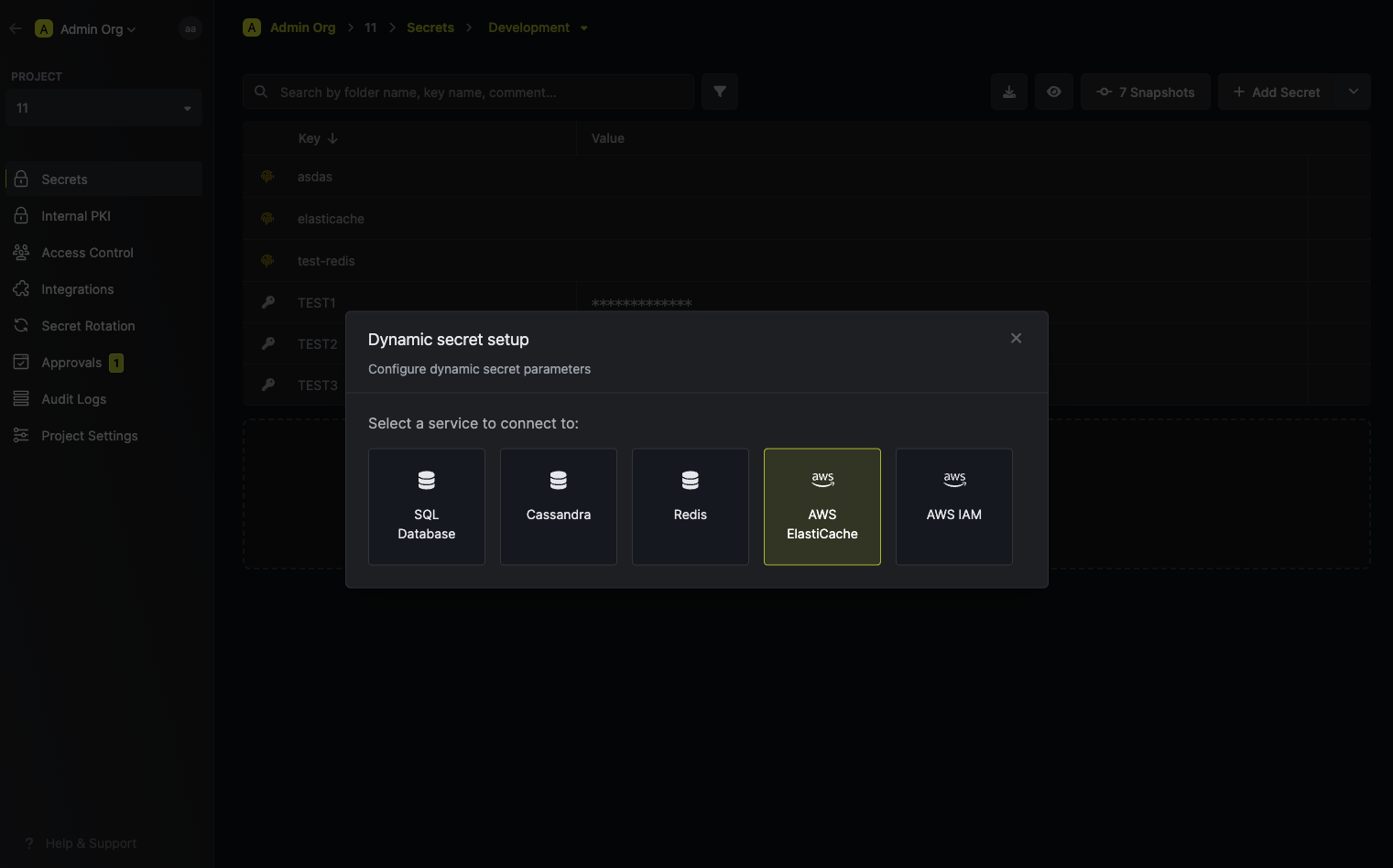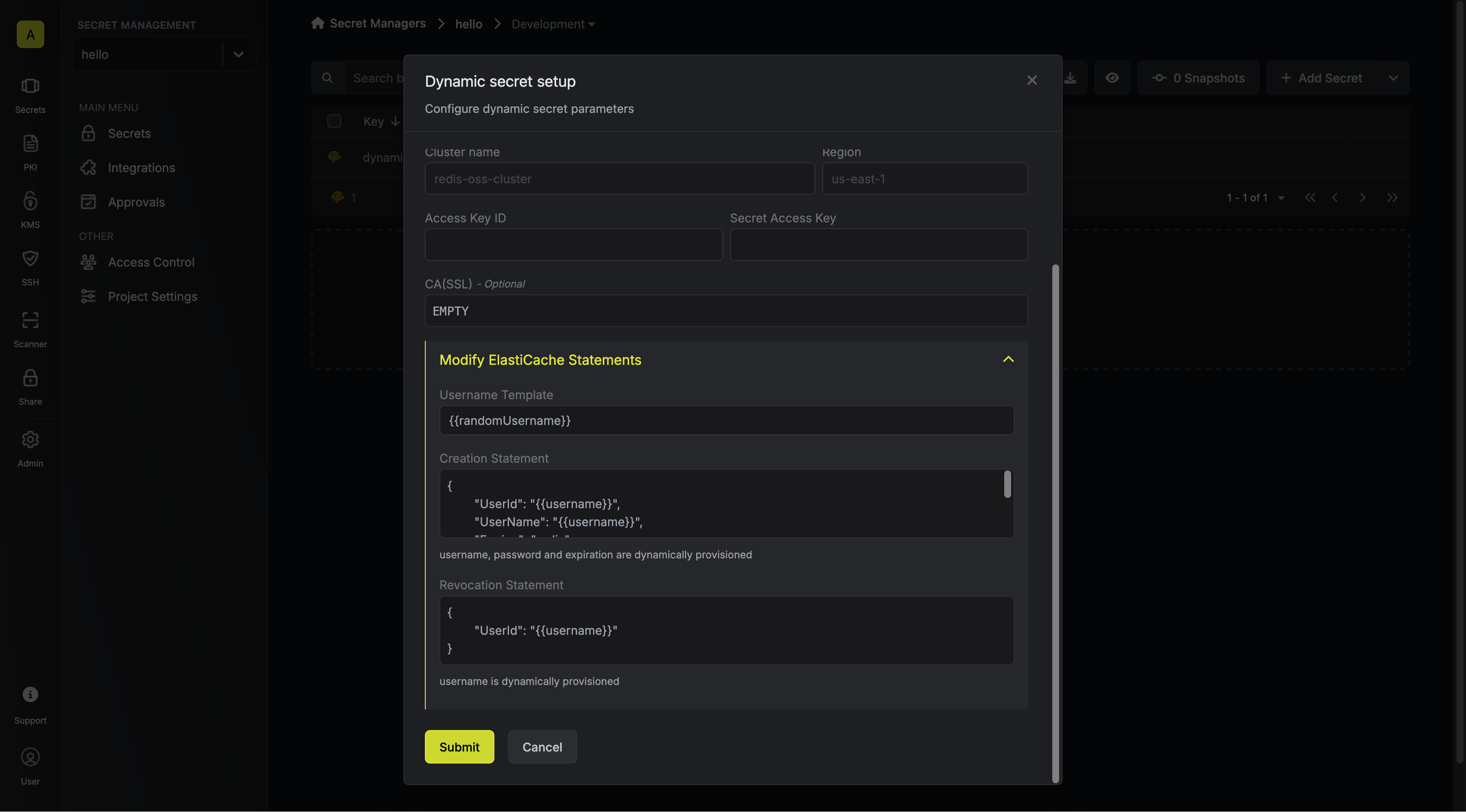Prerequisites
- Create an AWS IAM user with the following permissions:
- Create an access key ID and secret access key for the user you created in the previous step. You will need these to configure the Infisical dynamic secret.
New leases may take up-to a couple of minutes before ElastiCache has the chance to complete their configuration.
It is recommended to use a retry strategy when establishing new ElastiCache connections.
This may prevent errors when trying to use a password that isn’t yet live on the targeted ElastiCache cluster.While a leasing is being created, you will be unable to create new leases for the same dynamic secret.
Please ensure that your ElastiCache cluster has transit encryption enabled and set to required. This is required for the dynamic secret to work.
Set up Dynamic Secrets with AWS ElastiCache
1
Open Secret Overview Dashboard
Open the Secret Overview dashboard and select the environment in which you would like to add a dynamic secret.
2
Click on the 'Add Dynamic Secret' button

3
Select AWS ElastiCache

4
Provide the inputs for dynamic secret parameters
Name by which you want the secret to be referenced
Default time-to-live for a generated secret (it is possible to modify this value after a secret is generated)
Maximum time-to-live for a generated secret.
The region that the ElastiCache cluster is located in. (e.g. us-east-1)
This is the access key ID of the AWS IAM user you created in the prerequisites. This will be used to provision and manage the dynamic secret leases.
This is the secret access key of the AWS IAM user you created in the prerequisites. This will be used to provision and manage the dynamic secret leases.
A CA may be required if your DB requires it for incoming connections. This is often the case when connecting to a managed service.
5
(Optional) Modify ElastiCache Statements

Specifies a template for generating usernames. This field allows customization of how usernames are automatically created.Allowed template variables are
{{randomUsername}}: Random username string{{unixTimestamp}}: Current Unix timestamp{{identity.name}}: Name of the identity that is generating the secret{{random N}}: Random string of N characters
truncate: Truncates a string to a specified lengthreplace: Replaces a substring with another value
If you want to provide specific privileges for the generated dynamic credentials, you can modify the ElastiCache statement to your needs. This is useful if you want to only give access to a specific resource.
6
Click `Submit`
After submitting the form, you will see a dynamic secret created in the dashboard.
If this step fails, you may have to add the CA certificate.
7
Generate dynamic secrets
Once you’ve successfully configured the dynamic secret, you’re ready to generate on-demand credentials.
To do this, simply click on the ‘Generate’ button which appears when hovering over the dynamic secret item.
Alternatively, you can initiate the creation of a new lease by selecting ‘New Lease’ from the dynamic secret lease list section.
 When generating these secrets, it’s important to specify a Time-to-Live (TTL) duration. This will dictate how long the credentials are valid for.
When generating these secrets, it’s important to specify a Time-to-Live (TTL) duration. This will dictate how long the credentials are valid for. Once you click the
Once you click the 

 When generating these secrets, it’s important to specify a Time-to-Live (TTL) duration. This will dictate how long the credentials are valid for.
When generating these secrets, it’s important to specify a Time-to-Live (TTL) duration. This will dictate how long the credentials are valid for. Once you click the
Once you click the Submit button, a new secret lease will be generated and the credentials from it will be shown to you.
Audit or Revoke Leases
Once you have created one or more leases, you will be able to access them by clicking on the respective dynamic secret item on the dashboard. This will allow you to see the expiration time of the lease or delete a lease before it’s set time to live.
Renew Leases
To extend the life of the generated dynamic secret leases past its initial time to live, simply click on the Renew button as illustrated below.

